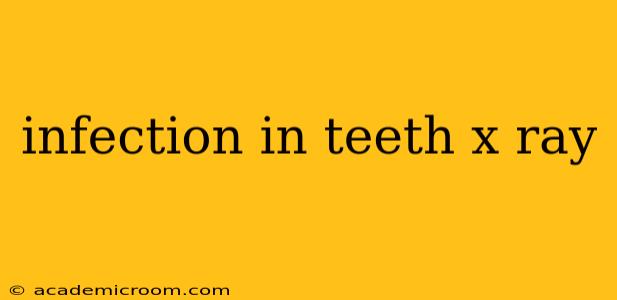Dental infections are a serious concern, requiring prompt diagnosis and treatment to prevent further complications. A dental X-ray is a crucial tool in identifying the location and extent of an infection within your teeth and surrounding structures. This comprehensive guide will explain what your dental X-ray can reveal about a potential tooth infection and answer common questions surrounding this important diagnostic tool.
What Can a Dental X-Ray Show Regarding a Tooth Infection?
A dental X-ray, specifically a periapical X-ray (which focuses on the root and surrounding bone), can reveal several telltale signs of a tooth infection:
-
Abscesses: An abscess appears as a radiolucent (darker) area at the root tip of the affected tooth. This indicates a pocket of pus caused by bacterial infection. The size of the abscess can indicate the severity of the infection.
-
Bone Loss: Infections can cause the destruction of the bone surrounding the tooth's root. This is visible on an X-ray as a loss of the normal, radiopaque (lighter) bone density around the root tip. Significant bone loss points to a more advanced infection.
-
Periodontal Disease: While not directly a tooth infection, periodontal (gum) disease can be revealed through X-rays. It shows as bone loss around the teeth, often appearing as a diffuse darkening around the roots. Untreated periodontal disease can lead to tooth infection.
-
Root Canal Issues: X-rays can identify issues within the root canal system, such as the presence of a root fracture, pulpitis (inflammation of the pulp), or the remnants of previous infection after a root canal.
How Can I Tell if an Infection is Present from My X-Ray?
It's crucial to understand that interpreting dental X-rays requires the expertise of a qualified dentist or oral radiologist. While the visual signs mentioned above are indicative of infection, a professional can accurately assess the extent and severity of the problem, considering the entire image and your clinical symptoms. Don't attempt self-diagnosis based solely on looking at your X-ray.
What are the Different Types of Dental X-Rays Used to Detect Infections?
Several types of dental X-rays can help diagnose tooth infections:
-
Periapical X-rays: These focus on a single tooth and its surrounding structures, providing detailed images of the root and bone. They are ideal for detecting abscesses and bone loss.
-
Bitewing X-rays: These show the crowns and proximal (side-by-side) surfaces of teeth, primarily used to detect cavities and periodontal disease. While not directly showing root infections, they can reveal bone loss indicative of the spread of infection from periodontal disease.
-
Panoramic X-rays: These provide a wide view of the entire mouth, including teeth, jawbones, and surrounding structures. They're useful for a general overview but may not offer the same level of detail as periapical X-rays.
What if My X-Ray Shows an Infection? What Happens Next?
If your X-ray reveals a tooth infection, your dentist will discuss treatment options with you, which may include:
-
Root Canal Treatment: For infections within the tooth itself, a root canal may be necessary to remove the infected pulp and seal the tooth.
-
Antibiotics: Your dentist may prescribe antibiotics to combat the bacterial infection, particularly if the infection is severe or has spread.
-
Extraction: In some cases, particularly with advanced infections or severe bone loss, tooth extraction may be the only option.
-
Surgical Drainage: For abscesses, a surgical procedure to drain the pus may be required to relieve pressure and allow the infection to heal.
Can a Tooth Infection Show Up on a Regular X-Ray?
Regular dental X-rays, including periapical and bitewing views, are specifically designed to detect tooth infections. However, the severity of the infection and the type of X-ray taken will significantly impact the visibility of the infection.
How Often Should I Get Dental X-Rays?
The frequency of dental X-rays depends on your individual needs and risk factors, as determined by your dentist. While recommendations vary, regular check-ups often include X-rays to catch problems early. Early detection significantly improves treatment outcomes and chances for saving the affected tooth.
This information is for general knowledge and does not constitute medical advice. Always consult with a qualified dentist for diagnosis and treatment of any dental problems.
